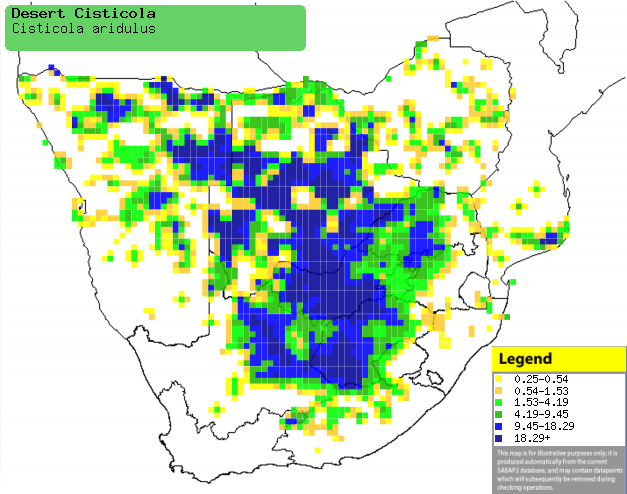|
Cisticola aridulus (Desert
cisticola)
[= Cisticola aridula]
Woestynklopkloppie [Afrikaans]; Motintinyane (generic term for
cisticolas and prinias) [South Sotho]; Kadhi-idhi-i, Timba (generic names for
cisticola) [Shona]; Matinti (generic term for cisticola) [Tsonga]; Kalahari-graszanger
[Dutch]; Cisticole du désert [French]; Kalahari-zistensänger [German];
Fuinha-do-deserto [Portuguese]
Life
> Eukaryotes >
Opisthokonta
> Metazoa (animals) >
Bilateria >
Deuterostomia > Chordata >
Craniata > Vertebrata (vertebrates) > Gnathostomata (jawed
vertebrates) > Teleostomi (teleost fish) > Osteichthyes (bony fish) > Class:
Sarcopterygii (lobe-finned
fish) > Stegocephalia (terrestrial
vertebrates) > Tetrapoda
(four-legged vertebrates) > Reptiliomorpha > Amniota >
Reptilia (reptiles) >
Romeriida > Diapsida > Archosauromorpha > Archosauria >
Dinosauria
(dinosaurs) > Saurischia > Theropoda (bipedal predatory dinosaurs) >
Coelurosauria > Maniraptora > Aves
(birds) >
Order: Passeriformes > Family: Cisticolidae
> Genus: Cisticola
Distribution and habitat
It occurs in patches along the Sahel semi-desert, extending
south to Ethiopia and Tanzania, with a separate population from Angola and
Zambia to southern Africa. Here it is locally common across much of the region,
preferring desert grassland, especially with Stipagrostis grass. It may
also occupy other types of dry grassland, sometimes with scattered trees and
bushes.
|
 |
|
Distribution of Desert cisticola in southern
Africa, based on statistical smoothing of the records from first SA Bird
Atlas Project (©
Animal Demography unit, University of
Cape Town; smoothing by Birgit Erni and Francesca Little). Colours range
from dark blue (most common) through to yellow (least common).
See here for the latest distribution
from the SABAP2. |
Predators and parasites
It has been recorded as prey of the
Black-footed cat (Felis nigripes)
Food
It eats small invertebrates, such as
spiders, grasshoppers (Orthoptera)
and beetles. It does most of its foraging low down in grassland, gleaning prey
from the grass and bare soil.
Breeding
- The nest is pear-shaped, with a large base and an entrance towards the
side of the smaller roof. It is usually built of dry grass reinforced and
attached with spider web to a grass tuft, typically less than half a metre
above ground.
- Egg-laying season is from about October-April, peaking from
December-March.
- It lays 2-5 eggs, which are probably incubated solely by the female in
about 14 days.
- The chicks stay in the nest for about 13-18 days, producing a sharp
hissing noise if touched.
Threats
Not threatened.
References
-
Hockey PAR, Dean WRJ and Ryan PG 2005. Roberts
- Birds of southern Africa, VIIth ed. The Trustees of the John Voelcker
Bird Book Fund, Cape Town.
|
